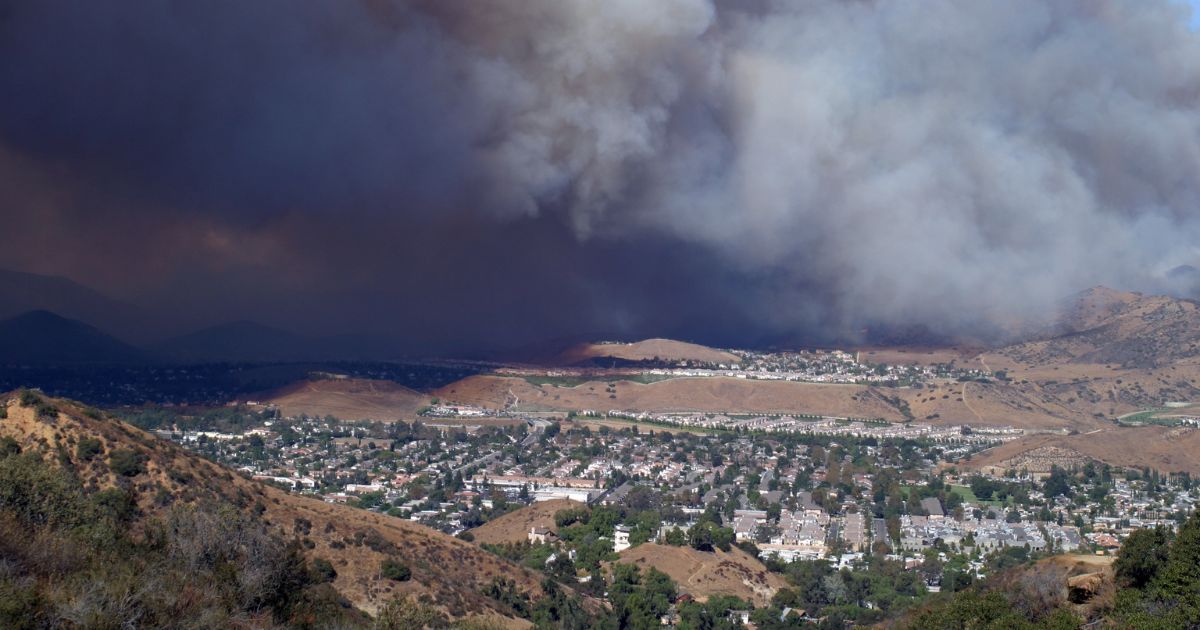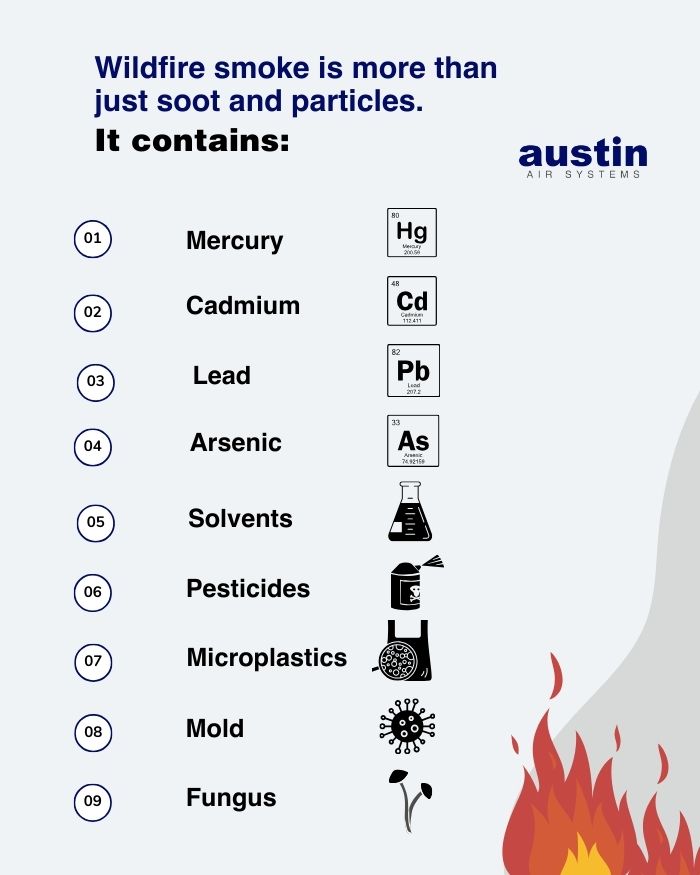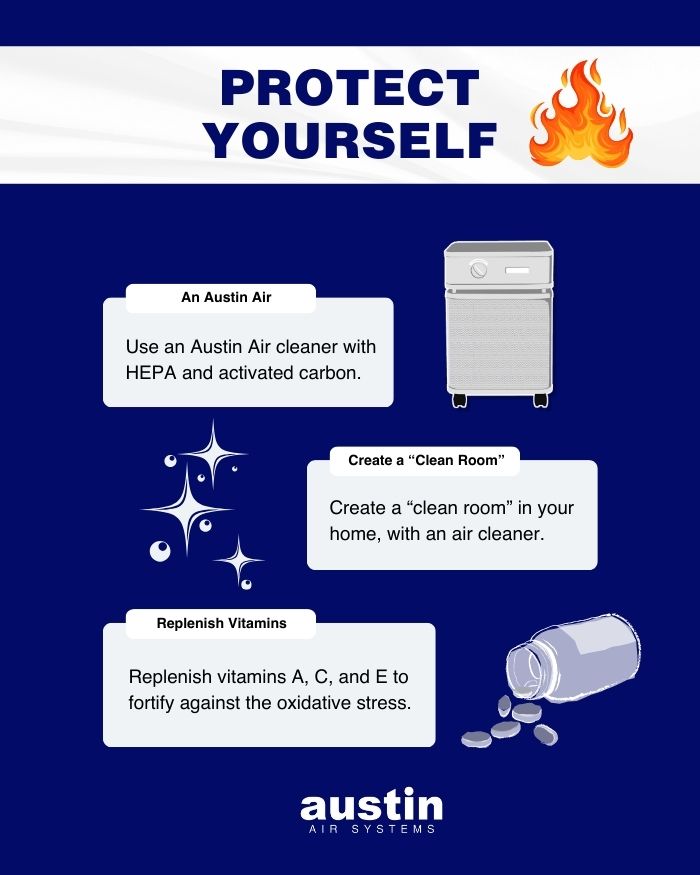As wildfires continue to burn for longer and in more places, the threat of negative health impacts from wildfire smoke is becoming increasingly intense. The devastation caused by wildfires stretches far beyond the immediate area in flames. Smoke carries a toxic payload that poses significant health risks to people hundreds and even thousands of miles away. Understanding the nature of wildfire smoke and its associated dangers is crucial for safeguarding your health. In this article, we’ll delve into four essential aspects of wildfires and why wildfire smoke is so perilous to our well-being.
Meet the Experts
For this discussion, we consulted two of our favorite naturopathic doctors for a discussion on the risks of wildfire smoke and how to protect yourself – Dr. Anne Marie Fine NMD, FAAEM and Dr. Lyn Patrick ND.
Dr. Anne Marie Fine, NMD, FAAEM, is a licensed and board-certified naturopathic physician specializing in Environmental Medicine with over twenty years of experience practicing medicine in California and Arizona. She is also an esteemed author with published works in international peer-reviewed journals, consultant, speaker, as well as an entrepreneur specializing in health products.
Dr. Lyn Patrick ND is a highly experienced naturopathic physician with over 35 years of private practice in Arizona and Utah. Her expertise spans environmental medicine, nonalcoholic fatty liver disease, endocrine disruption, and metal toxicology. Currently, she serves as Faculty for the Metabolic Medicine Institute Fellowship in partnership with George Washington School of Medicine and Health Sciences.
Both Dr. Fine and Dr. Patrick are founding directors and instructors at the Environmental Medicine Education International, instructing medical providers – doctors, nurses, nutritionists, psychiatrists, etc. – on how to treat the underlying causes of health issues, such as exposure to common environmental toxins, so “patients can move beyond symptom reduction and regain health.”
Issue #1. The Composition of Wildfire Smoke
Wildfire smoke is more than a mix of soot and ash. It is a complex combination of hazardous substances, including toxic metals such as mercury, lead, arsenic, and cadmium.
Mercury is one example that might come as a shock. According to Dr. Patrick, “as a result of the historic mining that happened in California there’s a significantly increased level of mercury in the trees in California […] trees absorb mercury from the atmosphere, especially coniferous trees. As a result, when those trees are burned there’s atmospheric mercury that is released.” Studies have shown that mercury in trees in California, as well as boreal (snow) forests in the Northwestern US and Canada, is released during wildfires and the atmospheric mercury has the ability to travel quite far.12
She warns: “We can absorb that inorganic mercury into our lungs from the air if we’re exposed to wildfire smoke.”
Dr. Patrick also emphasized that wildfires involving the burning of buildings introduce additional toxins into the mix, such as solvents, pesticides, and microplastics.
The little carbon particles act as carriers, they also have an electric charge that attracts and accumulates various pollutants like magnets or velcro, which then travel vast distances. These microscopic particles, laden with a cocktail of harmful chemicals, pose a severe threat to respiratory health and overall well-being.
Issue #2. The Reach of Wildfire Smoke
Wildfire smoke has a staggering ability to travel. Even individuals residing far from an inferno’s epicenter are not immune to its deleterious effects.
Dr. Patrick highlights how these smoke plumes can travel hundreds to thousands of miles, spanning continents and oceans. “We know [from] tracking the Canadian fires that those smoke plumes have gone thousands of miles. They’ve actually been detected in European countries. So it’s not just a matter of are we on the West Coast or on the East Coast. When fires happen there is almost a global exposure to these plumes….”
Dr. Fine further underscored the global reach of wildfire smoke by pointing to the Australian wildfires of 2019, where smoke with elements unique to Australia was detected in South America. “[The particles] jump continents, they jump oceans and they linger […]you don’t just look out your window and maybe see a hazy day and go, ‘Oh, I guess today I’m exposed to some wildfire smoke.’ It’s something to always be cognizant of.”
Monitoring tools like the air quality index published on AirNow.gov provide invaluable insights into local PM2.5 and ozone levels, offering individuals a means to gauge their exposure and take appropriate precautions. For example, if the AQI is between 101 – 150, or orange, it is considered “unhealthy for sensitive groups,” and people with underlying respiratory conditions like asthma and COPD should limit their time outdoors and avoid physical activity outside.3
Issue #3. Health Risks Associated with Wildfire Smoke
When considering wildfire smoke, it’s accurate to acknowledge its impact on the lungs. It exacerbates various respiratory conditions, ranging from COPD to asthma and allergies, intensifying their effects. The 2023 Canadian Wildfire increased ER visits for asthma in New York City by 70%. But the health ramifications of wildfire smoke extend beyond respiratory distress.
Dr. Patrick explains: “there’s another area of health that we know from many many clinical studies is very strongly affected by wildfire smoke – and that’s cardiovascular disease. Every aspect of the effect on the blood vessels, on the heart, is made worse by wildfire smoke. That would include heart arrhythmia (irregular heartbeats), peripheral vascular disease, damage to the blood vessels in the hands, the feet, the legs, and the arms.”4 The inhalation of fine particulate matter (PM2.5) penetrates not only the lungs but also the bloodstream, exerting detrimental effects on cardiovascular function.5
Studies reveal an elevated risk of heart attacks, strokes, and vascular damage among individuals exposed to wildfire smoke. Moreover, prolonged exposure exacerbates cognitive decline and neurological disorders. There is also an enduring impact of these airborne pollutants. Researchers have examined the population in the small Montana town of Seeley Lake who were exposed to high levels of wildfire smoke for 49 days in 2017. They’ve shown that lung function has declined for some residents in the two years since the fire happened – that’s right, the damage continued well after the smoke exposure had ended.6
Issue #4. Mitigating Risks with Proper Air Filtration
In light of the ongoing threat posed by wildfire smoke, investing in effective air filtration systems is paramount. The Environmental Protection Agency recommends the use of HEPA and activated carbon-based filtration technologies, like Austin Air purifiers. This combination of medical-grade HEPA and activated carbon offers robust protection against a broad spectrum of airborne contaminants, including volatile organic compounds (VOCs) and heavy metals present in wildfire smoke.
Austin Air, renowned for its innovative filtration solutions, champions a research-backed approach to air purification. Clinical trials conducted in collaboration with esteemed institutions like Johns Hopkins University attest to the efficacy of our filtration systems in alleviating respiratory symptoms and safeguarding cardiovascular and cognitive health.7
In fact, the EPA recommends that people living close to wildfire zones create a “clean room” in their home with an air purifier in a part of the house that doesn’t have contact with the outside air. Having an air purifier is a crucial part of clean room creation.
Dr. Fine also recommends that in addition to deploying advanced filtration technologies, replenishing antioxidants like vitamins A, C, and E can fortify the body’s defenses against the oxidative stress induced by wildfire smoke exposure.
*****************
The menace of wildfires extends far beyond the charred landscapes they leave in their wake. As most of North America can recall from the Canadian Wildfires of 2023, smoke can infiltrate distant communities. What everyone must be conscious of, is the fact that smoke is carrying a toxic payload that imperils respiratory, cardiovascular, and neurological health. By comprehending the composition and reach of wildfire smoke and adopting robust mitigation strategies such as advanced air filtration, individuals can mitigate the risks posed by these environmental catastrophes. As wildfires continue to escalate in frequency and intensity, proactive measures are imperative to safeguard public health and well-being against this formidable adversary.
The Austin Air Wildfire Toolkit has additional information on the health hazards of wildfire smoke as well as guidance on how to protect yourself and your family.
REFERENCES
1 McLagan DS, Stupple GW, Darlington A, Hayden K, & Steffen A. (2021 April 14). Where there is smoke there is mercury: Assessing boreal forest fire mercury emissions using aircraft and highlighting uncertainties associated with upscaling emissions estimates. Atmos Chem and Phys. 21(7), 5635–5653. doi: 10.5194/acp-21-5635-2021.
2 Sigler JM, Lee X, & Munger JW. (2003 August 19). Emission and long-range transport of mercury from a large-scale Canadian boreal forest fire. Envi Sci & Tech, 37(19), 4343–4347. doi: 10.1021/es026401r.
3 AQI Basics (n.d.). AirNow.gov. https://www.airnow.gov/aqi/aqi-basics/.
4 Wildfires may fuel heart health hazards: smoke exposure increases cardiovascular risks. (2023 June 7). American Heart Association. https://newsroom.heart.org/news/wildfires-may-fuel-heart-health-hazards-smoke-exposure-increases-cardiovascular-risks.
5 Hadley MB, Henderson SB, Brauer M & Vedanthan R. (2022 September 6). Protecting Cardiovascular Health From Wildfire Smoke. Circulation. 146(10), 788–801. doi: 10.1161/CIRCULATIONAHA.121.058058.
6 Houghton, K. (2021, March 3). In Montana, Tracking Long-Term Health Effects of Wildfire Smoke. Undark Magazine. https://undark.org/2020/09/23/wildfire-smoke-long-term-health/.
7 Raju S, Woo H, Koehler K, et al. (2022 October 26). Indoor Air Pollution and Impaired Cardiac Autonomic Function in Chronic Obstructive Pulmonary Disease. Amer J of Resp and Crit Care Med. 207(6). doi: 10.1164/rccm.202203-0523OC.



